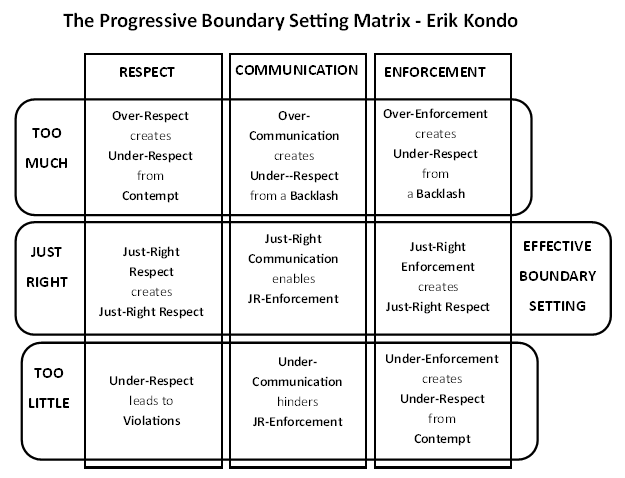
Over-Respect Creates Under-Respect
It takes giving Respect to receive Respect. That is a commonly used phrase. It makes sense. If you are not respectful to people, they are unlikely to be respectful to you in return. But what if you Over-Respect them? It is possible to give someone too much Respect?
Respect is considered to be such a universally desired quality, that the idea of giving too much Respect is rarely considered. Over-Respect comes in two basic forms. First, there the type that is described by the words: Awed, Idolize, and Glorify. This is “Impressed Based Respect”. In this case, one person puts the Respected Person high on a pedestal. The idolized person can do no wrong. But rather than generating reciprocal Respect, this type of Over-Respect usually creates feelings of Contempt in the Respect Person. Contempt is a form of Under-Respect. Contempt is an emotional response, it doesn’t depend on logic to be created. The end result is that Over-Respect creates Under-Respect.
The other type of Over-Respect is described by the words: Intimidated, Browbeaten, Bullied, Cowed, Daunted, Frightened, Pacified, and Submitted. This is “Fear Based Respect”. In this case, the Respected Person is essentially feared by the other. But what makes it Over-Respect is that the fear is not necessarily warranted for the situation.
What both of these types of Over-Respect have in common is that the Over-Respected person has significant power over the other person. This power has not been earned, it has been given to him or her by the other. Absolute power corrupts absolutely, and so it is with Over-Respect.
For example, the stereotypical situation of a man who idolizes a woman, who in turn treats him poorly (contemptuously) really does happen. And so does, the stereotypical woman who lives in fear that if she speaks her mind to any man, he will physically attack her. The men she submits to, in return, feel Contempt for her obvious fear. Just as the Man may justify his adoration with rationalizations and excuses, so may the Woman justify her fear with the explanation that all men are dangerous.
Since Contempt is an emotion. Its creation is not always logical. But it is common for people to not value what is not earned. When Respect is given too freely, it loses its value. When you feel that people are afraid of you for no reason, you tend to not Respect them.
Over-Respect is in the eye of the Beholder(s). Some people may regard themselves as deserving of so much Respect that Over-Respect is rarely created. But some see being Over-Respected as a sign of weakness in the other person. This perception of weakness turns into Under-Respect which may turn into future Violations.
Video Links
Under-Communication Hinders Just-Right Enforcement
The purpose of communication is to aid enforcement by conveying the rules of behavior (boundaries). Without clear communication appropriate (Just-Right) enforcement is difficult to achieve.
Some words for Under-Communication are:
Silence, Beat around the bush, Imply, Misinform, Mislead.
Some people violate the rules unintentially because they don’t understand the rules of behavior.
Other people violate the rules intentionally because they have no respect for the rules of behavior.
If both these violations are handled similarly, it will result in preceptions of Over-Enforcement for unintential violations and Under-Enforcement for intential violations.
If a person who has committed an unintential violation is punished to the same degree as someone who has committed an intentional violation, it is likely that the Beholder(s) will feel it is Over-Enforcement.
If a person who has committed an intential violaton is punished to the same degree as someone who has committed an unintential violation, it is likely that the Beholder(s) will feel it is Under-Enforcement.
Both of these situations will lead to less Respect for the rules of behavior.
When individuals don’t effectively define the rules of acceptable behavior, they are depending on other people to “know” the rules and also to respect those rules. Inevitably, some people will violate the rules. When a boundary was not clearly conveyed, the violated person doesn’t really know whether the violation was intential or unintentional. As a result, he or she will have difficulting determing the appropriate level of enforcement.
Under-Communication creates gray areas, whereas clear communication creates well defined boundaries. Effective communiction removes doubt that a violation was unintentional. Under-Communication on the other hand, leads to uncertaincy. The Violator may not have understood the rules, and the Violated doesn’t know if the Violator understood the rules. In this situation, the appropriate level of enforcement is in doubt.
It is not unusual for people who are uncomfortable with verbal assertiveness to rely on body language as their primary method of boundary communication. The problem with body language is that it can be easily misinterperted or ignored. When a boundary violation ocurrs, many of these people keep repeating their body language in the hope it may work at some point. This is a classic example of Under-Communication.
It is not uncommon for some of these people to become frustrated at repeatedly having their boundaries violated. This bottled frustration eventually leds to an emotional outburst of Over-Communication along with the associated Backlash. In many cases, it was the fear of a Backlash that caused the person to engage in Under-Communication in the first place. It was only their anger that switched them to Over-Communication. These individuals’ method of communication is emotion based. It is not guided by the goal of creating clear communication.
Groups of people or sub-cultures can also engage in systematic Under-Communication. Typically, in places where there exists persistent and recurring social problems, there is also chronic Under-Communication. Colleges in the United States are examples of systemic Under-Communication in terms of sexual assault. The vast majority of students have never read their college’s policy on sexual assault. Many them do not know the legal definition of consent. Many students’ personal interactions are characterized by gray areas and communication inhibited by alcohol. Personal boundaries are broken and violated on a continious basis. The end result is sparce and inconsistent enforcement that creates both contempt for the rules in some cases, and a backlash against the rules in others. Effective enforcement is rare, and the problem of sexual assault continues year after year.
Under-Communication can be best identified by it’s lack of effectiveness. If the level of communication used is not creating understanding, it needs to be changed to a higher level. When an effective level of communication has been achieved, the use of enforcement becomes less necessary. And when enforcement is required, it can be done with more conviction at an appropriate (Just-Right) level.
Over-Communication Creates Under-Respect from a Backlash
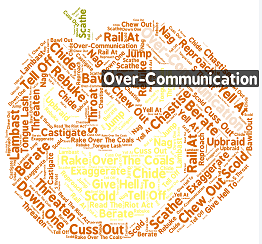
The purpose of Communication is to enable Enforcement of the rules of behavior. Before the rules can be enforced, people need to understand the rules. Otherwise, the rules will be continuously violated due to a lack of understanding. But once understanding has been achieved, only those that don’t Respect the rules, violate them.
The goal of clear communication is to create understanding. But Over-Communication does not increase understanding. Over-Communication means that the other person “gets it”. He or she knows what the rules are, yet the communication continues unabated. Over-Communication creates an emotional backlash that leads to Under-Respect.
Some words for Over-Communication are:
Threaten, Berate, Nag, Exaggerate, Chide, Rebuke, Reproach, Scold, Castigate, Bawl out, Chew out, Cuss out, Tongue lash, Tell off, Rake over the coals, Rail at, Give hell to, Chastise, Lambast, Jump down one’s throat, Read the riot act, Scathe, Upbraid, Yell at, and more.
The multitude of words for Over-Communication is testament to how often it happens. The use of Over-Communication makes the target feel defensive and resentful. There is a large grey area where communication and enforcement intersect. Many times, people who engage in Over-Communication are ineffectively using it as a means of enforcement.
Sometimes, people use Over-Communication to vent their frustrations. In this case, the goal is not to create an understanding of the rules. The communication is a verbal and/or written retaliation for the emotional benefit of the communicator. In this way, Over-Communication is a parallel to Over-Enforcement. It is about the feelings of the enforcer. It is not about enabling Just-Right Enforcement (appropriate) with the goal of creating Respect.
It is easy for most people to think of examples of Over-Communication in their own life. Most likely, everyone has engaged and been targeted by Over-Communication many times. Therefore, it should also be simple to remember the emotional effect of this Over-Communication. How it led to less respect, not more.
Over-Communication can also be seen on a multi-person scale. Many social justice activists regularly engage in Over-Communication as they repeat the same mantra as part of their cultural change/awareness campaigns. For example, assume a small segment in any particular Group engage in some type of unwanted behavior, but the entire Group is lectured on not breaking the rules. Many of those that already know the rules and respect the rules, will resent what they feel to be an Over-Communication. As with Over-Enforcement, Over-Communication is in the eyes of the Beholder(s).
The end result is that many of the targeted Group will feel defensive and alienated. They will lose some of their prior Respect. The longer and more intense the Over-Communication, the greater the Backlash against it. Many in the field of social justice have no concept of the dangers of Over-Communication. They think the more communication the better. In their minds, there can never be enough awareness about their issue of choice.
Effective communication must be gauged by its result. The goal of clear communication is to create understanding in order to enable enforcement. Beyond that, it becomes Over-Communication and will eventually lead to Under-Respect for the rules of behavior.
Over-Communication is determined by a person’s point of view. The following videos are examples of what I consider to be Over-Communication. Other people may have a different opinion, which is one of the many complications of creating effective communication.
Just-Right Enforcement Creates Just-Right Respect
Many people think that enforcement creates respect. But in reality, sometimes it does and sometimes it doesn’t. For those who see enforcement creating respect, it is easy to believe that more enforcement leads to more respect. These people tend to use Over-Enforcement. There are also those who think that any level of enforcement will create respect, even a low level. These people tend to use Under-Enforcement.
Some word for Just-Right Enforcement are:
Measured response, Appropriate, Balanced, Just-Right, Evenly applied, Keep in line, Correct, Discipline, Follow through, Consequence
The truth is that enforcement is a double edge sword. Its use doesn’t always create respect. Only Just-Right Enforcement leads to Just-Right Respect. An inappropriate level of enforcement will lead to Under-Respect.
Just-Right Enforcement creates Just-Right Enforcement by creating a deterrence to unwanted behavior. If deterrence is not sufficient to change behavior, then Just-Right Enforcement can also create Respect through the elimination of disrespectful behavior. To put it simply, elimination is to vote the offender off the island, or banishment, or the extreme version – make the offender walk the plank.
The key to Just-Right Enforcement is that it must be appropriate for the situation in the eye of the Beholder(s). The Beholder(s) is usually the rule breaker. But witnesses and bystanders are Beholders too. Therefore, while it is important that the enforcer see the enforcement as Just-Right, it is more important that the Beholders see it as Just-Right. If the Beholders see it as either Under-Enforcement or Over-Enforcement then Under-Respect will be created. “The punishment must fit the crime” in order for it to be effective.
For systems (environments) that have reoccurring violations, determining what is the most effective level of enforcement is a process of trial and error. Those systems that consistently use Just-Right Enforcement provide ever increasing stability and security through effective Boundary Setting. On the other hand, those systems that don’t use appropriate enforcement are plagued with ongoing violations and a lack of security.
When Boundary Setting is working, there is minimal need for enforcement. People follow the rules as a matter of course. The environment is safe and secure. Environments with ineffective Boundary Setting are either noticeably filled with policing agents or stand out by their complete lack of policing.
It is very difficult to find videos that show examples of Just-Right Enforcement. The final determination of an act of enforcement’s effectiveness really depends on the aftermath. Video clips rarely provide context. Therefore, the appropriateness of any level of enforcement is subject to viewer interpretation (in the eye of the Beholder).
What looks like Just-Right Enforcement to one person may look like Over-Enforcement to another, and appear to be Under-Enforcement to a third. In fact, this is the critical point that most people don’t understand about enforcement. The appropriate level of enforcement is not a fixed quantity. It is dynamic. It is fluid. It changes. It is situation dependant. And different people will view and judge it from different paradigms. In fact, Just-Right may be best defined by what it is NOT. Just-Right is not Over-Enforcement and is not Under-Enforcement. The proper level of enforcement ultimately must be gauged on its ability to create Respect for the Rules of behavior.
When there exists a feeling of appropriate enforcement as part of effective Boundary Setting in an environment, people literally feel safe and secure enough to wear no pants.
Video Links
Under-Enforcement Creates Under-Respect from Contempt
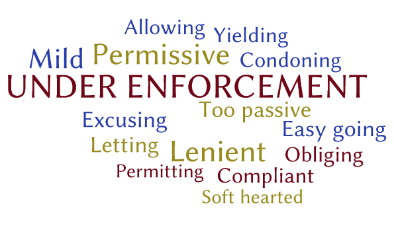
Under-Enforcement is the opposite of Over-Enforcement. But it doesn’t create the opposite effect. Under-Enforcement also creates Under-Respect. It does so by the creation of Contempt.
Some words for Under-Enforcement are:
Lenient, Permissive, Too passive, Excusing, Compliant, Allowing, Easy going, Condoning, Letting, Mild, Obliging, Permitting, Soft-hearted, Yielding
Under-Enforcement creates Under-Respect which is also known as:
Contempt, Distain, Disrespect, Antipathy, Disregard, Derision, Neglect, Distaste, Defiance, Aversion, Disgust, Pity
These words all represent an emotional reaction. Under-Respect is not based on logic. It would be logical to assume that if someone is “too nice” to you, then you would respond in kind. But, people tend to take advantage of people who are too nice to them. When it comes to dealing with a violation of the rules, Under-Enforcement does not create the deterrent necessary to change unwanted behavior.
Under-Enforcement differs from Over-Enforcement in that it creates a less powerful emotion than Over-Enforcement. Over-Enforcement has the potential to immediately escalate into an ever expanding cycle of response and counter-response. The Contempt created by Under-Enforcement is likely to develop a little slower. As a result, Under-Enforcement can be followed by a progressively higher level of enforcement.
Under-Enforcement provides the opportunity to step up to Just-Right Enforcement. But Over-Enforcement is harder to step down from. Therefore, it is generally better to start low and move progressively (rapidly if necessary) higher. Than to start high and try to move lower. Once a Backlash has been created it is difficult to dissipate it. Contempt on the other hand, is easier to erase with a higher level of enforcement.
For example, you might speed at the threat of a $50 dollar fine. But as the fine increases, it is likely to create a greater and greater deterrent. The point at which the fine changes your behavior to following the speed limit is Just-Right Enforcement.
The following video is an example of how Under-Enforcement by the police, led to the rioters attacking them in mass.
This next example shows a domestic violence situation where the boyfriend is repeatedly slapped. He makes no attempt to enforce his personal boundary of acceptable behavior. Clearly, his girlfriend has Under-Respect for him.
This next video shows an old man who is repeatedly touching women as they pass by him. There is no enforcement of his unwanted behavior, so he continues to do it. Enforcement could come from the victims, or it could come from bystanders, or the police.
Just as in Over-Enforcement, what constitutes Under-Enforcement is in the eye of the Beholder. Under-Enforcement can be judged by its effectiveness. The goal of enforcement is to change behavior. It creates Respect by the elimination of disrespect. When the unwanted behavior continues, it is a sure sign that the level of enforcement is too low.
Given that both Under-Enforcement and Over-Enforcement create Under-Respect, it is easy to see why boundary setting has the potential to fail. A systemic failure occurs when the enforcer believes that his or her level of enforcement is appropriate for the situation, but the violator sees it as Under-Enforcement. In this case, the enforcer is only looking at the level of enforcement relative to herself. She is not taking into consideration how the violator views it.
Another systemic boundary setting failure occurs among people who are overly afraid of creating a Backlash via Over-Enforcement. These people will consistently Under-Enforce due to fear of Over-Enforcement. They don’t progressively increase their enforcement level to reach Just-Right Enforcement. As a result, the create Contempt. This contempt leads to further and most likely more severe violations of behavioral rules.
A common example of this situation, is a young socially conditioned woman, who is afraid to assertively standup to a man who is giving her unwanted attention. Her fear of making him angry leads her to behave in a passive submissive manner. The man, seeing that he can break her personal boundaries without consequence will now have a greater level of Under-Respect for her.
This type of woman doesn’t understand that in many situations, assertive (not aggressive) use of her voice is all that is needed to enforce her personal boundaries. She also doesn’t understand that a predatory man with a high level of bad intent will be greatly encouraged by her passive submissive behavior.
This final video shows the abduction of Carlie Brucia who was later found raped and murdered.
NOTE: Many people’s lifetime of social encounters have conditioned them to respond in a certain manner to conflict. Most likely, this response proved to be successful in most social situations. Thus, it has become the person’s default response. The problem arises when the conflict is not social, but asocial/predatory. In this situation, social responses of passive Under-Enforcement and/or verbal Over-Communication are likely to lead to a disastrous result.
Over-Enforcement Creates Under-Respect from a Backlash

When a Beholder(s) (violator/bystanders/witness/etc) feels that he or she has been subject to, or has witnessed an Over-Enforcement response, he or she has an emotional reaction of feelings of unfairness. The greater the perceived unfairness, the greater the emotion. This response is the Backlash (resentment, blowback) against both the Enforcer and/or the Rule being enforced. Sometimes, the Backlash response happens immediately, sometimes the Backlash builds over time. Regardless of when the Backlash response happens, Under-Respect is created.
Some common words for Over-Enforcement are:
Too severe, Excessive, Overreaction, Disproportionate, Retaliation, Payback, Too aggressive, Pummel, Thrash, Avenge, Overdone, Overreach, Unreasonable, Revenge, Punishment, Retribution, Too Harsh, etc.
For example, in the 80’s cult classic movie the Breakfast Club, there is a scene that begins with Bender telling the Teacher to “Eat my shorts”. This was a violation of the rules of respectful student/teacher interaction. What follows is an escalating cycle of Violations and Over-Enforcements that result in everyone including the viewing audience to develop Under-Respect for the Teacher. But, most likely in the eyes of Teacher, his enforcement was Just-Right under the circumstances.
- Eat My Shorts (Breakfast Club: “Eat my shorts” – Begins at 1:05)
Below is video a backlash in the form of a mob beating of multiple police at a soccer game. Four police are seen tackling a running fan waving a flag. They submit him and one appears to repeatedly jab him with his club. In response to this perceived unnecessary use of force, one then two fans intervene. Within seconds, hundreds of fans and players have swarmed the policemen. The police are beaten as they try to flee to safety. At least one officer is severely injured in the melee.
Some of the fans believed that the action of the policemen was an Over-Enforcement for the violation of interfering with the game. This belief resulted in a Backlash and mass attack of the police. Had the police merely tackled the Fan and escorted him off the field, it is unlikely that a Backlash would have been created. Everyone knew the flag waving Fan violated the rules. The issue was the magnitude of the resulting enforcement of the violated rule.
This next video describes an incident regarding a school’s Zero Tolerance policy. The factual reporting of the incident may be inaccurate, but regardless, it serves as an example of Over-Enforcement. Apparently, Student A took a razor away from Student B, who intended to cut herself. Student A then reported the incident and brought razor to the school Principal. Student A was subsequently suspended under the school’s zero tolerance policy regarding the possession of weapons.
The video commentators and presumably much of the video audience regard Student A’s punishment as an Over-Enforcement of the school’s ban on weapons. As a result, they have less support and Under-Respect for the school’s policy. The purpose of this video is to help build a larger backlash against Zero Tolerance in schools.
In these examples, the important point to keep in mind, is whether an enforcement is Too Little, Too Much, or Just-Right is in the eyes of the Beholders. And in these three cases, the enforcements used did not serve to create Just-Right Respect. They served to create Under-Respect via a Backlash. Thus, they are example of ineffective Boundary Setting.
This final video is a news story regarding a fatal shooting in a movie theatre that was the result of a conflict between two men over texting.
A Backlash created by the use of Over-Enforcement may come from the laws of society. In this case, Society is the Beholder and it casts judgement upon whether someone’s response was Over-Enforcement or not. The determination of the appropriate use of enforcement now becomes a legal issue. Therefore, it is important to clearly understand the legal consequences involved with the use of force, particularly deadly force.
Many times, Over-Enforcement is used by people who feel they deserve more Respect. As a result of feeling that they are Under-Respected, they see violations as being greater. Or they see violations that other people don’t see. This is the classic example of “Having a chip on your shoulder”.
Having a personal narrative that self-identifies you as an Under-Respected person or member of and Under-Respected Class also leads to the perception of more violations. You see the world not from rose colored glasses, but from disrespected glasses. Therefore, you are constantly enforcing what you consider to be violations of respectful behavior to you and/or your Under-Respected class. You see yourself as an innocent victim of other people’s wrongful behavior. As a result, you feel you must punish these wrongs.
The problem is that other people may be reacting to your behavior. They may not consider their own actions to be violations, only you do. Therefore, your enforcement responses are likely to be viewed as Over-Enforcement and create a Backlash. The end result is that your Boundary Setting efforts actually create less, not more Respect for you.
Just-Right Communication Enables Just-Right Enforcement
The goal of effective boundary setting is to eliminate violations. Violations are eliminated by the creation of Respect. Respect is created by Just-Right Enforcement. In order to create Just-Right Enforcement, Just-Right Communication is required.
Just-Right Communication enables Just-Right Enforcement because
1. It is NOT Under-Communication which creates confusion about the rules.
2. It is NOT Over-Communication which creates a Backlash against the rules.
3. It is an effective method of conveying the rules and also the consequences of breaking the rules.
Just-Right Communication is informative. It reduces misunderstandings about the rules. When there is Just-Right Communication, potential Violators and Beholders understand what the rules are. They understand how the rules will be enforced. Therefore, it is less likely that enforcement actions will be viewed as either Under-Enforcement or Over-Enforcement, and more likely that enforcement will be viewed as Just-Right or appropriate for the situation.
Regardless of whether Just-Right Communication comes from society or if it comes from individuals, it is an essential part of boundary setting. For individuals, Just-Right Communication is essentially assertive communication. It is neither passive nor aggressive. It is declaratory. It is clear. When communication is used effectively, it reduces the need for enforcement.
People and societies which habitually have their boundaries encroached upon and violated usually do not practice effective communication. Either they habitually engage in Under-Communication or they engage in Over-Communication. There is not an exact formula for what constitutes effective communication. Every situation will determine the most effective level of communication. The level may vary as the situation varies. Learning to execute Just-Right Communication is an important step in boundary setting by ultimately reducing violations through the creation of respect.
Just-Right Respect Creates Just-Right Respect

Respect begets respect. It takes respect to get respect. You have to give respect to receive respect.
These are all common sayings that represent a shared truth. Respect is an elusive concept. You can ask for respect, but you may not get it. You may demand more respect and get less respect in return. Respect is sometimes learned, but generally speaking respect is earned.
In society, respect is part of the public trust. In a secure society, the citizens have an ample amount of respect for each other and the society’s institutions. As a society becomes less secure, this public trust and respect starts to deteriorate. People become less trusting each other less. They become start to feel that governmental institutions do not have the peoples’ best interests at heart.
The downward cycle continues as respect is replaced by fear and distrust. On the other hand, reversing this spiral requires adding more trust and respect into society. People become less fearful and more trusting of each other. The bottom line is that most people need to feel respected in order to give respect to others. The most effective amount of respect is neither too much nor too little, it is a Just-Right amount.
Under-Respect Leads to Violations
Under-Respect doesn’t by itself create willful violations of the rules. Violations require not only the intention to violate in the form of a lack of respect, they also require the violators have the means and opportunity to create the violation. It is for this reason that Under-Respect leads to violations. While it is theoretically possible that all those people with Under-Respect don’t have the means and opportunity to commit violations, the most likely result of more people with Under-Respect is more violations.
Under-Respect can also be thought of as a lack of deterrence to committing a violation(s). People with minimal deterrence to committing a violation are more likely to commit one when they have the means and opportunity to do so. On the other hand, people who have Respect for the rules have an internal deterrence to breaking the rules.
Therefore, violations are generally increased in society when there is more Under-Respect in the form of less Respect for the rules. The same goes for individuals. People who are Under-Respected are more likely to have their boundaries encroached upon and experience violations than individuals that are Respected. Therefore, on a societal basis, more people with Under-Respect for the rules leads to more violations in society. Additionally, more people in society who are Under-Respected will also lead to more violations in society.
The end result is that less Respect in society leads to more violations of the rules. And when more people have the means and opportunity to break the rules, there are more likely to be violations.
TOO MUCH

Yes, you can have too much of a "good thing".
This is something that most people intuitively understand. But when it comes to promoting a viewpoint, many times it gets forgotten.
We may all agree that self-confidence is a "good thing". But when someone has too much self-confidence and becomes arrogant, that excess self-confidence now becomes a "bad thing".
Therefore, it is important to recognize the point in which the "good thing" is now starts causing harm or decreasing effectiveness. In this case, there is too much of "something". The more of that "something", the worse the situation gets.
This situation can be decribes by the downward sloping curve. The exact shape of the curve varies depending upon the factors involved.
TOO LITTLE

There are many times we need more of "something" in order to better accomplish a task or become more efficient. This situation is symbolized by the saying "The more the merrier."
The more of that "something" available, the more efficiently the problem gets solved.
The graph is a line that slopes up from left to right. In this case, the amount available is less than the optimum amount.
In terms of self-confidence, when someone has low self-esteem, he or she has too little self-confidence. More would be better (up to a point).
JUST-RIGHT
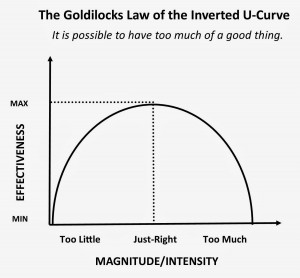
Just-Right is a theoretical place where there is the optimum amount of "something" which creates maximum effectiveness. This amount is neither too little, nor is it too much. It is Just-Right or appropriate for the situation.
This concept is decribed by the Inverted U-Curve. This curve is also known as the Kuznet's Curve.
Many arguments and disagreements are the result of people viewing the situation from different sides of the Inverted U-Curve. In other words, people with seemingly opposing viewpoints may actually agree on the fundamental concept. But they may disagree on whether a certain (known, perceived, imagined) quantity of that concept should be increased or decreased.
RESPECT

Respect is the foundation of civilization. Respect and trust work hand in hand. Societies in which the citizens have respect for the laws and rules behavior are also the ones in which the people have trust in their government. These are secure societies where the majority of people do not live in constant fear of crime and for their personal safety.
Respect is also the foundation of personal success and security. For individuals, respect consists of both respect for oneself (self-respect) and also respect for others.
Respect is also a misunderstood concept. Many people demand that they be respected. Many advocates demand that their cause be respected. Many schools have the word Respect prominently displayed. What these people don't understand is that respect does not come to those who just ask for it. Respect must be earned and created.
Respect for a person (including self-respect) is created by one's actions and behaviors. In order to receive respect, you must also give respect to others. Conversely, those that don't respect themselves are not respected by others in return.
Respect for the rules and laws of human behavior comes from appropriate enforcement of those rules and laws. People who under enforce their personal boundaries are not respected. People who over enforce their boundaries are also not respected. Only a Just-Right amount of enforcement relative to the situation develops respect.
COMMUNICATION

t is not enough to just have rules of behavior. The rules must be clearly communicated. There are many forms of communication. Interpersonal communication consists of mainly body language, verbal and written words, and physical actions.
Communication that refers to acceptable and unacceptable human behaviors are boundaries. These boundaries can be societal or they can be individual.
Rules are violated due to a misunderstanding of the rules, or due to a lack of respect for the rules. The breaking of a boundary is a violation of the rules. In order to determine an appropriate response, it is necessary to determine whether the boundary was violated knowingly or unknowingly.
Clear communication of the rules, elimninates violations that ocurr unknowingly or from misunderstanding the rules. Therefore, a violation of a clearly communicated boundary leaves no doubt as to the presence of lack of respect. In such a situation, enforcement is required. Communication has failed and it is necessary to use a higher level response.
The more effective a person or a society is at communicating the rules of behavior, the less there is a need for enforcement. Conversely, people and societies that don't effectively communicate the rules are forced to rely more on enforcement. Many times this enforcement will be viewed as Over-Enforcement by those that misunderstood the rules. Thus leading to a backlash.
ENFORCEMENT

Enforcement is used to create respect for the rules of behavior. When there exists a large amount of respect, there is little need for enforcement. Conversely, when there is minimal respect, more enforcement is required. The concept of enforcement applies to both individuals and societies.
When people talk about the Carrot and the Stick, the Stick is enforcement. Society uses criminal punishment and penalties as a means to create respect for the laws and rules of society.
But enforcement must be appropriate (Just-Right) in order to create respect. When enforcement is too little or not enough (Under-Enforcement), it creates contempt for the rules of behavior. On the other hand when, enforcement is too much (Over-Enforcement), it creates a backlash against the rules.
Contempt is a form is disrespect for the rules. A backlash is also a form of disrespect for the rules. It is for this reason that it is so important to apply an appropriate level of enforcement. Enforcement by itself does not create respect. It is only when the level of enforcement is viewed as fair or equal to the level of violation, that respect is created.
Enforcement is a higher level response than Communication. The use of force is part of the Physical Fence. When communicaton fails, it is time to use enforcement. The reason that Progessive Responses are so important is that the wrong level of enforcement will not have the desired result of building respect. It could build disrespect.
Effective Boundary Setting
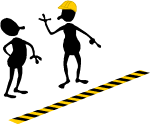
The purpose of Boundary Setting is to control and limit unwanted behaviors in order to create trust and security in society and for individuals.
Boundary Setting is a fundamental aspect of civilization. Boundary Setting occurs in most areas of people’s lives from families to employment to international relationships and more.
All people and all entities in society engage in boundary setting at some level. When boundary setting is done effectively, people and societies are able to function smoothly. When boundary setting is not done effectively problems arrise.
People and societies that are unable to effectively set boundaries are plagued with ongoing and systemic violations. It is not enough to just engage in boundary setting, it must be done effectively to achieve the desired result.
Progressive Boundary Setting Matrix
The Progressive Boundary Setting Matrix is a framework for understanding and implementing boundary setting. It is based on several fundamental ideas.
1. Most actions can be categorized under the Goldilocks Principle of Too Little or Just-Right or Too Much for the situation. This is the concept of balance and appropriateness.
2. When it comes to human beings, every action doesn’t always result in an equal and opposite reaction. Actions that are either Too Little or Too Much, many times result in a greater response creating escalating consequences. Therefore, it is important to have a strategy guide toward responses being Just-Right or appropriate for the situation.
3. The Progressive Boundary Setting Matrix shows that effective Boundary Setting systems must contain a Just-Right level of Respect, Communication, and Enforcement. Any other combination will cause the system to become unstable and not control unwanted behaviors.
4. Each of the three fundamental components of Respect, Communication, and Enforcement can be subdivided into three separate categories of Too Little, Just-Right, and Too Much. Ineffective Boundary Setting systems invariably apply Too Little and/or Too Much.